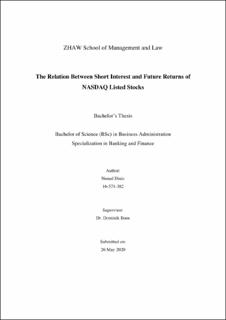Please use this identifier to cite or link to this item:
https://doi.org/10.21256/zhaw-21593| Publication type: | Bachelor thesis |
| Title: | The relation between short interest and future returns of NASDAQ listed stocks |
| Authors: | Dinic, Nenad |
| Advisors / Reviewers: | Boos, Dominik |
| DOI: | 10.21256/zhaw-21593 |
| Extent: | 51 |
| Issue Date: | 2020 |
| Publisher / Ed. Institution: | ZHAW Zürcher Hochschule für Angewandte Wissenschaften |
| Publisher / Ed. Institution: | Winterthur |
| Language: | English |
| Subject (DDC): | 332.6: Investment |
| Abstract: | The short interest of a stock refers to the total amount of shares shorted by traders, professional investors and hedge funds, who profit from a decline in the stock price. Market participants can gain an informational advantage if the short interest level of a stock contains relevant information about the future share price development. Although prior research has shown that stocks with high short interest levels are more likely to experience negative abnormal returns in the following months, the relation has not been widely investigated for NASDAQ listed securities during the rising equity market from 2012 to 2019. The aim of this Bachelor’s thesis is to analyse the one-month abnormal return of NASDAQ listed stocks with either a very low or a very high short interest level during the period 2012 to 2019. Both the short interest as a percentage of float (SIPF) and the short interest ratio (SIR) are applied to determine which metric provides higher and more significant abnormal returns. Stocks are ranked each month to form equal-weighted portfolios based on either the SIPF or the SIR level retrieved from Bloomberg. The lightly shorted portfolios include securities below the 1st and 10th percentiles, while the heavily shorted portfolios contain stocks above the 90th and 99th percentiles. To evaluate the absolute performance, the total return over the entire period, as well as the geometric average return, is determined. Abnormal returns are estimated through ordinary least squares regressions and by applying two different multi-factor asset pricing models. The empirical results indicate that portfolio formations based on the metric SIPF deliver higher and more significant returns than ones sorted by SIR, regardless of the asset pricing model. Lightly shorted portfolios generate significant excess returns when containing stocks below the 1st percentile (1.1% per month) and below the 10th percentile (1.0% per month). In contrast, the heavily shorted portfolios experience a significant negative abnormal return if they comprise stocks above the 90th percentile (-0.9% per month) and above the 99th percentile (-1.4% per month). In conclusion, short interest as a percentage of float can be a valuable sentiment indicator for forecasting the future share price development of NASDAQ listed securities. The findings of this study confirm prior research suggesting that buying stocks with a very low short interest level potentially leads to higher returns for investors, while stocks with a very high short interest level should be avoided or sold due to the high probability of underperforming considerably. Further studies could investigate the relation between short interest and the subsequent stock return for non-U.S. markets. It would be desirable to implement short interest estimations from financial data providers covering shorter time periods – for example, on a day-to-day or week-to-week basis. |
| URI: | https://digitalcollection.zhaw.ch/handle/11475/21593 |
| License (according to publishing contract): | CC BY 4.0: Attribution 4.0 International |
| Departement: | School of Management and Law |
| Appears in collections: | BSc Betriebsökonomie |
Files in This Item:
| File | Description | Size | Format | |
|---|---|---|---|---|
| 2020_05_26_Bachelor's_Thesis_Dinic_Nenad.pdf | 687.78 kB | Adobe PDF |  View/Open |
Show full item record
Dinic, N. (2020). The relation between short interest and future returns of NASDAQ listed stocks [Bachelor’s thesis, ZHAW Zürcher Hochschule für Angewandte Wissenschaften]. https://doi.org/10.21256/zhaw-21593
Dinic, N. (2020) The relation between short interest and future returns of NASDAQ listed stocks. Bachelor’s thesis. ZHAW Zürcher Hochschule für Angewandte Wissenschaften. Available at: https://doi.org/10.21256/zhaw-21593.
N. Dinic, “The relation between short interest and future returns of NASDAQ listed stocks,” Bachelor’s thesis, ZHAW Zürcher Hochschule für Angewandte Wissenschaften, Winterthur, 2020. doi: 10.21256/zhaw-21593.
DINIC, Nenad, 2020. The relation between short interest and future returns of NASDAQ listed stocks. Bachelor’s thesis. Winterthur: ZHAW Zürcher Hochschule für Angewandte Wissenschaften
Dinic, Nenad. 2020. “The Relation between Short Interest and Future Returns of NASDAQ Listed Stocks.” Bachelor’s thesis, Winterthur: ZHAW Zürcher Hochschule für Angewandte Wissenschaften. https://doi.org/10.21256/zhaw-21593.
Dinic, Nenad. The Relation between Short Interest and Future Returns of NASDAQ Listed Stocks. ZHAW Zürcher Hochschule für Angewandte Wissenschaften, 2020, https://doi.org/10.21256/zhaw-21593.
Items in DSpace are protected by copyright, with all rights reserved, unless otherwise indicated.